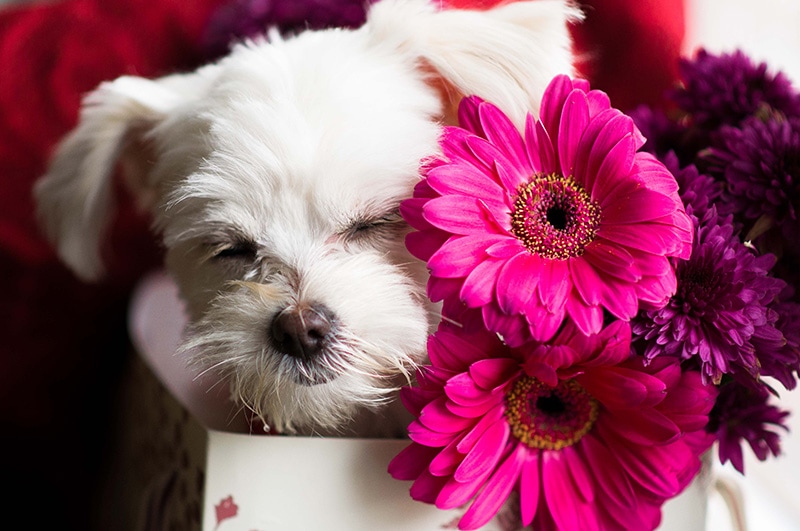Chi Apso (Chihuahua & Lhasa Apso Mix): Pictures, Info, Care Guide & More

Updated on

Click to Skip Ahead
The Chi Apso is a unique combination of two opposite breeds—the Mexican Chihuahua and the Tibetan Lhasa Apso. Despite their differences, both breeds are ancient companion dogs that were sacred to their people. They also share some personality traits, including tenacity, loyalty, intelligence, and a stubborn streak.
If you want to bring home one of these hybrid dogs, find out everything you need to know to care for a Chi Apso, including what you can expect for appearance, temperament, and health.
| Height: | 10–11 inches |
| Weight: | 13–15 pounds |
| Lifespan: | 12-15 years |
| Colors: | Black, white, cream, brown, pied |
| Suitable for: | Single owners, families with older children |
| Temperament: | Adaptable, playful, smart |
The Chi Apso is a unique combination of the Lhasa Apso, which originated in Tibet as a companion dog for monks in monasteries, while the Chihuahua is an ancient breed that was a companion and ceremonial dog for the Toltec people in Mexico. Despite their different origins, both breeds are small with big personalities, unwavering bravery, and fierce loyalty.
Chi Apso Characteristics
Chi Apso Puppies

Chi Apso mixes are neither purebred dogs nor a developing designer breed, so it may be difficult to find breeders and puppies. You may find an experimental breeder with a litter or accidental litters for sale, however. These dogs show up in shelters and rescues often as well.
However, be cautious if you come across Chi Apso puppies from questionable breeders. Like other hybrid breeds, the Chi Apso may be produced in puppy mills, which have deplorable conditions for the parents and puppies. These dogs often have behavioral and health problems as adults.

Temperament & Intelligence of the Chi Apso
Though the Chi Apso is a new hybrid combination, they come from two well-established breeds with nearly century-old breed recognition and standards. Both the Chihuahua and the Lhasa Apso were bred as companion dogs and share watchdog traits, as well as confidence, bravery, and liveliness, which may show in the mixed puppies.
Are These Dogs Good for Families? 👪
The Chi Apso can be a good dog for families with older children, but be wary with young children. These small breeds may not tolerate their behavior, but it depends on which parent the puppies take after. The Lhasa Apso are better around children than Chihuahuas. If you do keep a Chi Apso in a home with young children, make sure to carefully supervise interactions to avoid injuries to the dog or children. Some Chi Apso dogs could be nippy and defensive.
Does This Breed Get Along With Other Pets? 🐶 😽
Chi Apso mixes may get along well with other dogs and cats, but it depends on the individual dog. The Lhasa Apso are suspicious of new people and dogs, while the Chihuahua can be defensive due to their size. While neither of these dogs has the high prey drive of the hunting breeds, they may chase or harass cats and other small animals.
Things to Know When Owning a Chi Apso:
If you want to bring a Chi Apso into your home, it’s important to prepare for their unique needs. While they’re adaptable, they have specific requirements you need to be aware of to ensure you’re providing the ideal home. Here’s everything you need to know.
Food & Diet Requirements 🦴
Lhasa Apsos and Chihuahuas need high-quality food and careful portion control. Small dogs like these can be overfed easily, leading to obesity and other health problems. The Lhasa Apso, in particular, needs quality protein and fat to support their coat, but Chihuahuas are more prone to overeating and obesity. It’s important to find the right balance to ensure your pup gets the nutrition they need without adding excess calories and weight. Speak with your vet about your dog’s nutrition if you have concerns.

Exercise 🐕
As companion breeds, both the Lhasa Apso and the Chihuahua can be couch potatoes. You may find that your dog will have short bursts of energy to run around or play, but then they relax quickly. Lhasa Apsos are more energetic than the Chihuahua, but neither breed has vigorous exercise requirements. That said, it’s crucial to provide enrichment for these smart dogs to prevent boredom and destructive behaviors.
Training 🎾
Chihuahuas and Lhasa Apsos are alert, intelligent dogs that aim to please, though they can both be stubborn. You have to establish strict boundaries and consistent commands from the start to avoid problem behaviors. The Chihuahua can have a “terrier” temperament as well, so focus on positive reinforcement that avoids aversive techniques or bullying.
Grooming ✂️
The grooming demands of the Chi Apso depend on which parent breed your puppy takes after and the length of the coat. Lhasa Apsos have long coats that need to be brushed regularly and bathed every few weeks. Chihuahuas have short coats that are easier to maintain, but they often need warm dog sweaters or coats in cold weather.
Health and Conditions 🏥
Both Lhasa Apsos and Chihuahuas are generally healthy dogs, but they are prone to certain genetic conditions. Chihuahuas may have potential heart problems, eye disease, and joint problems, including patellar luxation. The biggest health problem for the Lhasa Apso is hereditary kidney dysfunction, which can’t be screened in genetic testing. Otherwise, these dogs can develop health conditions that are a concern for all breeds, such as parasites, joint problems, skin problems, and cancer.
- Skin problems
- Joint problems
- Cancer
- Kidney dysfunction
- Heart problems
- Eye disease
- Parasite infestation
Male vs Female
Though some owners claim that male or female dogs have an advantage, the differences are minimal. Most dogs are individuals, so choosing a male or female depends on your preferences. Many of the behaviors that are associated with male or female dogs are due to sex hormones, such as roaming, marking, and aggression, so it’s important to get your dog spayed or neutered. This not only prevents a lot of problem behaviors but reduces the risk of reproductive health conditions like pyometra and certain types of cancer.
3 Little-Known Facts About the Chi Apso
1. They Have Mythology
As ancient breeds, the Lhasa Apso and Chihuahua have mythology associated with them. Tibetan Buddhists believe that dogs come before humans in the reincarnation process and that priests are reborn as Lhasa Apsos before being reborn as humans. Chihuahuas have similar lore to the Aztecs, who sacrificed a Chihuahua to guide their nobility through the underworld after death.
2. They Have Unique Names
In Tibet, the Lhasa Apso is known as the Abso Seng Kye, which means the “bark lion sentinel dog.” These dogs were used to guard Tibetan dwellings and resemble the mythical snow lion. Conversely, the Chihuahua is named after the Mexican state of Chihuahua.
3. They’re Bred for Opposite Climates
Originating in Mexico, the Chihuahua was bred for warm, balmy climates and needs additional protection in the cold. The Lhasa Apso was bred to survive the cold of the Himalayan Mountains, so they have a long, thick double coat that can be straight or wavy. How you care for your Chi Apso depends on which coat it inherits.
Final Thoughts
Whether your Chi Apso takes after the Chihuahua with a short or light coat, a terrier-like personality, and a relaxed personality, or the Lhasa Apso with a thick double coat and an aristocratic bearing, you can count on a dog that’s the ideal combination of bravery, loyalty, and love.
Featured Image Credit: Valeria Plusnina, Shutterstock













